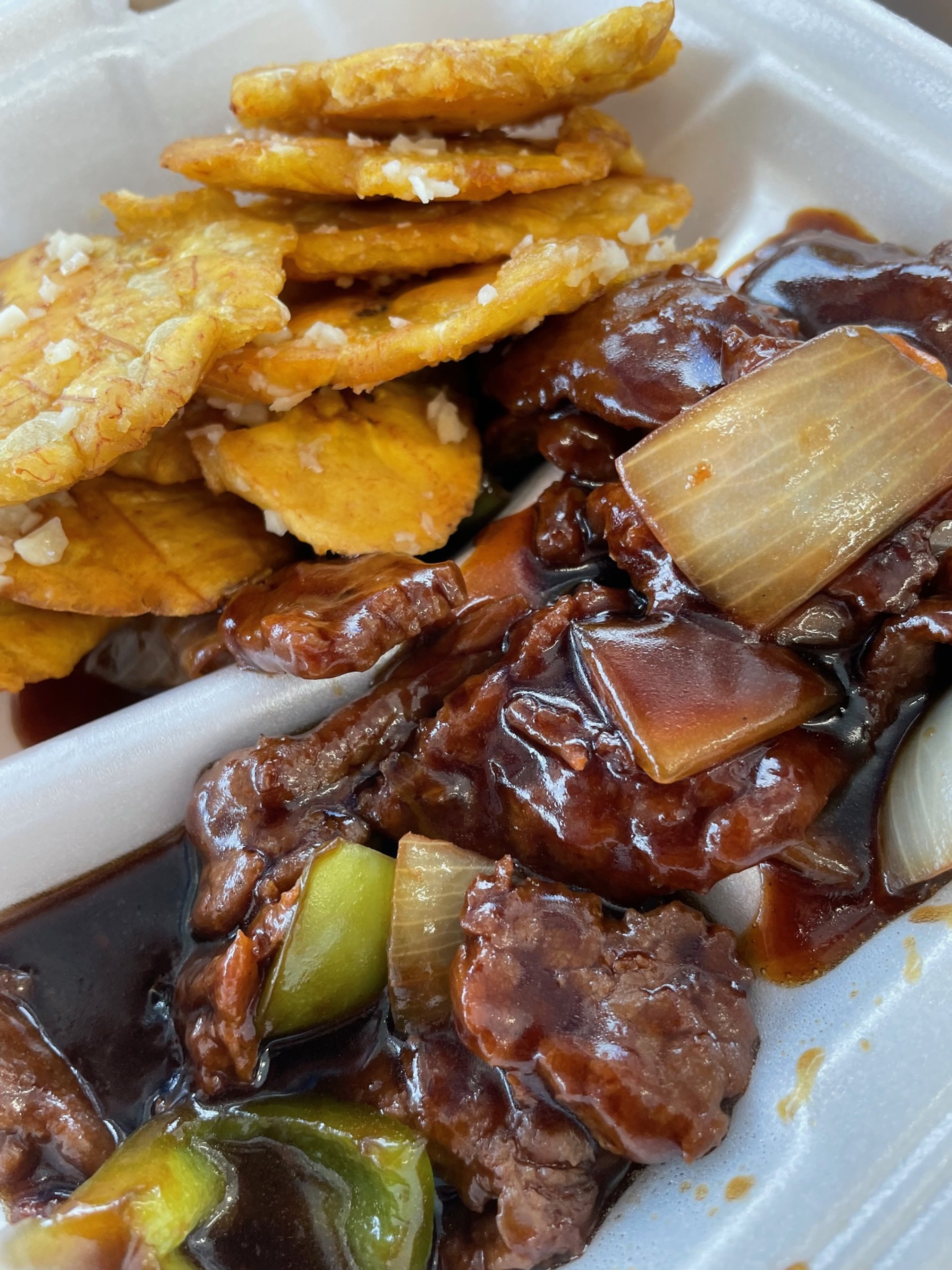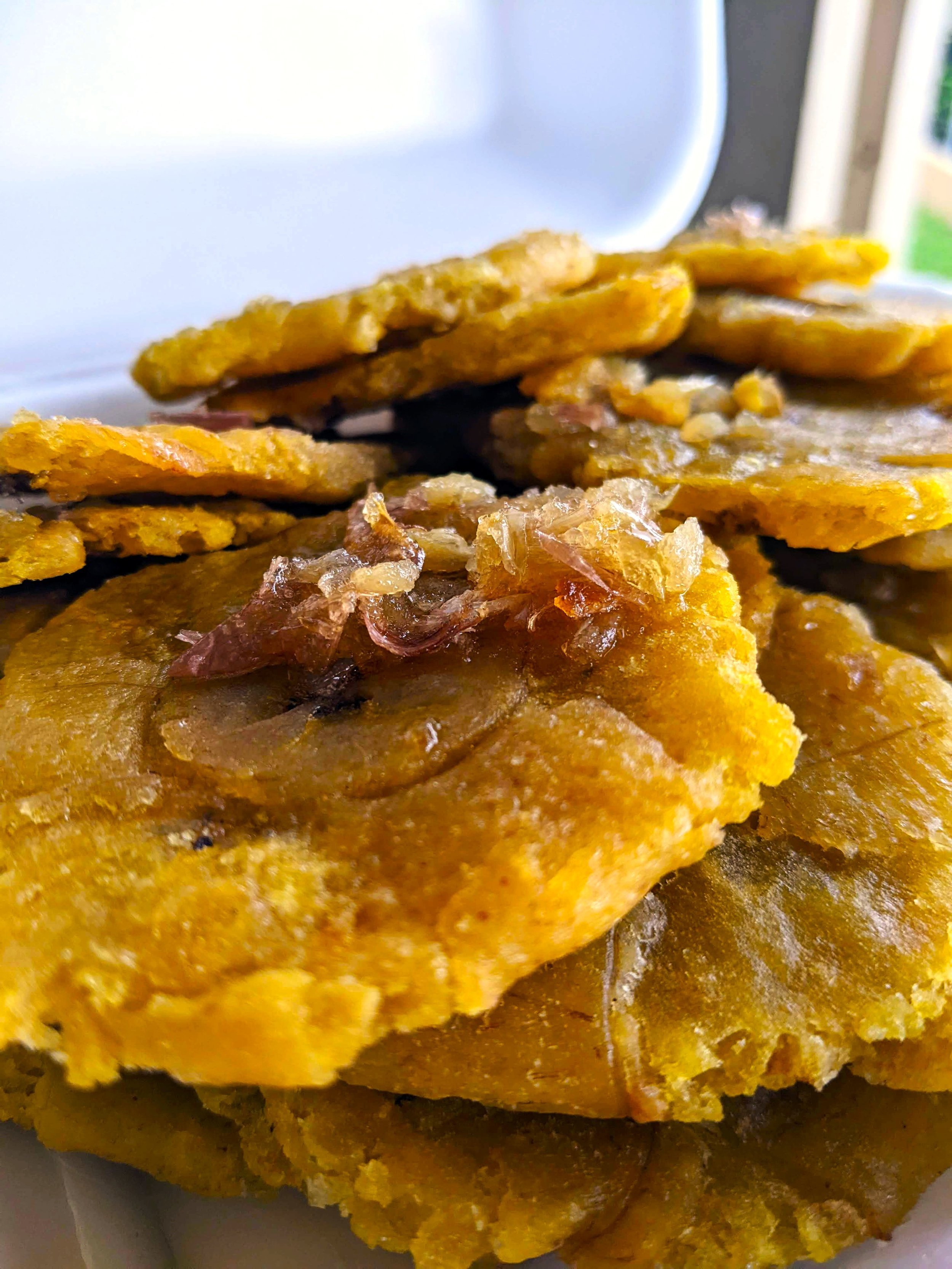Plantains, Garlic, Oil, and Sugar: The Sacred Family Dinner
All foods connect us to an other: coffee prepared by a grandparent or parent, the ever present sandwichitos de mezcla at an aunt’s house, for example. We create rituals, routes, and networks around those foods, we anticipate them. With them, we also make sense of our time-space. For me and two friends, one of the foods that has become a ritual is tostones con ajo, or mashed plantains with garlic, from the Chinese restaurant close to a bridge in Cabo Rojo, my hometown. Between displacement, stages of growth, romance, work struggles, and many other things that wish to bring us down, the tostones con ajo are always there as a healing food. Opening our mouths to devour the double-fried green plantain, dipped in oil with garlic, sugar, and salt, we consume other stories of displacement, growth, and even romances. But in that act of reflection, there is perhaps a healing potential.
The Scared Family Dinner
Chinese food or comida de los chinos was present while I was growing up, although always as a way of breaking with everyday life and establishing a family ritual. In hindsight, it gave my mom a break from the kitchen and served as a way to feed three children in a single income household. A family meal #1: ½ gallon of rice, 10 chicken pieces, 1 box of fries= $24.95, at today's price. At the time I did not understand that, through ritual, we approach the sacred. Perhaps that is one of the reasons for the privileged place of Chinese-Puerto Rican or chino-criollo restaurants in Puerto Rico. The sacred is made up of “dimensions of spiritual work,”¹ according to M. Jacqui Alexander. Furthermore, it implies an affective practice that recognizes mutual respect, complicity, and sensorial solidarity.²
Tostones con ajo or a combination of pepper steak with rice and fries incorporate a relationship with the sacred that appeals to complicity and sensorial solidarity. Living in the Puerto Rican diaspora, I never thought I would miss the feeling of risking my life by swallowing more than one tostón con ajo. The feeling of the starchy plantain refusing to go down, causing an obstruction of the airway. I also did not think I would drive two and a half hours from Austin to Houston looking for a Chinese-Puerto Rican restaurant to relive that culinary experience. But the sacred requires a certain pilgrimage, reaching a promised land or a space that embodies what we consider sacred. We relate to the sacred in Chinese-Puerto Rican food because, as María Sotomayor de la Cruz³ reflects, it is the epitome of comida criolla. It contains the displacements and the bodies that are not claimed as “being Puerto Rican” and calls upon the making and practicing of community.
(Un)comfortable Foods
During the 19th century, the Caribbean became a space where various diasporas converged and as a result came to share what Tao Lei Goffee calls the “bittersweet inheritance of sugar.”⁴ The first migratory wave of Chinese immigrants to the Caribbean occurred during the 19th century through the British colonies to work in the cultivation of sugarcane, when the abolition of slave labor was already on the horizon.⁵ ⁶ ⁷ From this wave, historian José Lee Borges shares, Puerto Rico received Chinese braceros escriturados or indentured workers from Cuba who had been imprisoned and whose sentences were served in Puerto Rico in part by working on the Carretera Central.⁸ The subsequent migratory waves, according to Lee Borges, occurred during the second half of the 20th century. These migrations were “intertwined with the emergence of new economic-industrial projects in Puerto Rico, the entry of various groups of immigrants, and the rebirth of the Chinese community in the United States.”⁹ ¹⁰ This stage is also influenced by the migration of Chinese-Cubans as a result of the 1959 Cuban Revolution. It is during this period that Chinese food restaurants and ice cream parlors such as the well-known REX Cream were established in the Puerto Rican archipelago.
The arrival of the Chinese workers followed a very similar path to that of enslaved African workers. As a consequence, in their daily lives, both diasporas were forced to transform their kitchens abroad and “demonstrated re-creation and invention.”¹¹ Although the labor of Chinese immigrants ensured the continuation of the sugar economy in the Caribbean, these culinary fusions are not understood as part of the “official” Caribbean culinary tradition. Rather, these dishes—as with the bodies of Asian diasporas and Afro-Asians—are seen as foreign and often othered. For example, in Elogio de la fonda¹²—a series of gastronomic chronicles that describe the space of the fonda in Puerto Rico—writer Edgardo Rodríguez Juliá chooses not to include Chinese-Puerto Rican restaurants. This despite the fact that its definition of a fonda refers to a “humble restaurant that serves food at reasonable prices”, but in which the food “has a homestyle flavor” that is characterized by the kind treatment typical of family businesses: a definition that well-suits Chinese-Puerto Rican restaurants. In other words, although Chinese-Puerto Rican restaurants are essential in the food routes of Puerto Ricans in the archipelago and in its diaspora, this type of establishment has no place in the imaginary of la fonda criolla. As Sidney Mintz and others suggest about the study of certain food traditions and their relationships: “We ought not to continue to look at Western and Eastern food practices as if they were on different planets, when we are given more evidence everyday that they are not.”¹³ Even more so in a space like the Caribbean in which, as Stuart Hall explains, everyone comes from somewhere else.¹⁴
Afro-Asian Futuristic Cuisine
Tostones con ajo, fried chicken, and arroz frito play on the Puerto Rican imaginary of comfort food. For instance, tostones con ajo, whose distinctive but unknown ingredient is sugar, reflect the trajectory of colonial machinery and the colonization of Caribbean agricultural landscapes. The banana is a crop that was introduced by Spanish colonizers. It originated on the African continent and was domesticated by Spanish hands on Canarian soil, before being brought to America.¹⁵
The creativity in cooking methods used mainly by Afro-descendant bodies during the European colonial period represents both an act of resistance and survival,¹⁶ as cooking was determined by the few crops made available to enslaved people to ensure productivity.
The plantation normalizes and organizes the bodies.¹⁷ ¹⁸ ¹⁹ However, there are culinary practices—like the tostones con ajo—that challenge this normalization of bodies in the afterlives of the plantation system: they continue to affirm a life of ease through “innovation and improvisation on the margins of plantations.”²⁰ Tao Leigh Goffe explains that, in response to forcefully induced innovation, Afro-Asian artists' gastro-poetic practices contain the ability to metabolize food “in ways that grapple with the futurity of the plantation to form a new intertwined genealogy of black and Chinese womanhood.”²¹ In this way, through tostones con ajo, we approach a similar gesture practiced by everyday chefs and professionals from the Asian and African diaspora. Cooking is always a process of transformation, possibility, and re-creation. As such, combining garlic, plantains, and sugar, and frying them in a familiar way speaks of the future of the plantation and the liberation of bodies conditioned to this space-time. Our relationship with the sacred, practiced through culinary ritual, is born from these stories of violence, invention, creativity, and resistance.
—
Footnotes
¹ Alexander, M. Jacqui, Judith Halberstam, and Lisa Lowe. Pedagogies of Crossing Meditations on Feminism, Sexual Politics, Memory, and the Sacred (Durham: Duke University Press, 2005), 7.
² Ellis Neyra, Ren. 2020. The Cry of the Senses: Listening to Latinx and Caribbean Poetics. Dissident Acts (Durham: Duke University Press), 17.
³ Sotomayor de la Cruz, María. “Dame una orden de tostones con ajo”: Sobre los restaurantes chinos criollizados. 80grados, (August 2022).
⁴ Goffe, Tao Leigh. “Sugarwork: The Gastropoetics of Afro-Asia After the Plantation”. Asian Diasporic Visual Cultures and The Americas 5, (2019): 34.
⁵ Goffe, “Sugarwork”, 33.
⁶ Benítez Rojo, Antonio. Archivo de los pueblos del mar (San Juan: Ediciones Callejón, 2010), 39.
⁷ Lee Borges, José. Los chinos en Puerto Rico. Ediciones Callejón, 2016. 19.
⁸ Lee Borges, Los chinos en Puerto Rico, 21.
⁹ All translations from Spanish are my own.
¹⁰ Lee Borges, Los chinos en Puerto Rico, 22.
¹¹ Cheung, Sidney C. H., and David Y. H. Wu. The Globalization of Chinese Food (London: Routledge, 2013), 56.
¹² Rodríguez Juliá, Edgardo. Elogio de la Fonda (San Juan: Plaza Mayor, 2001).
¹³ Cheung and Wu, The Globalization of Chinese Food, xix.
¹⁴ Hall, Stuart. “Negotiating Caribbean Identities.” New Left Review 209 (1995): 6.
¹⁵ Ortiz Cuadra, Cruz M., and Russ Davidson. Eating Puerto Rico: a History of Food, Culture, and Identity (Chapel Hill: University of North Carolina Press, 2013), 138.
¹⁶ Mintz, Sidney W. Tasting Food, Tasting Freedom: Excursions into Eating, Culture, and the Past (Boston: Beacon Press, 1996), 14.
¹⁷ Allewaert, Monique. Ariel’s Ecology: Plantations, Personhood, and Colonialism in the American Tropics (Minneapolis: University of Minnesota Press, 2013).
¹⁸ McKittrick, Katherine. “Plantation Futures.” Small Axe 17, no. 3 (2013): 1–15.
¹⁹ Wynter, Sylvia. “Novel and History, Plot and Plantation,” Savacou, no. 5 (June 1971): 95-102.
²⁰ Goffe, “Sugarwork”, 40.
²¹ Goffe, “Sugarwork”, 31.
Mónica B. Ocasio Vega is a doctoral student in Iberian and Latin American Literatures and Cultures at the University of Texas in Austin. She studies the relationship between food, reading, and writing in Caribbean cookbooks, food blogs, cooking shows, and literature.



